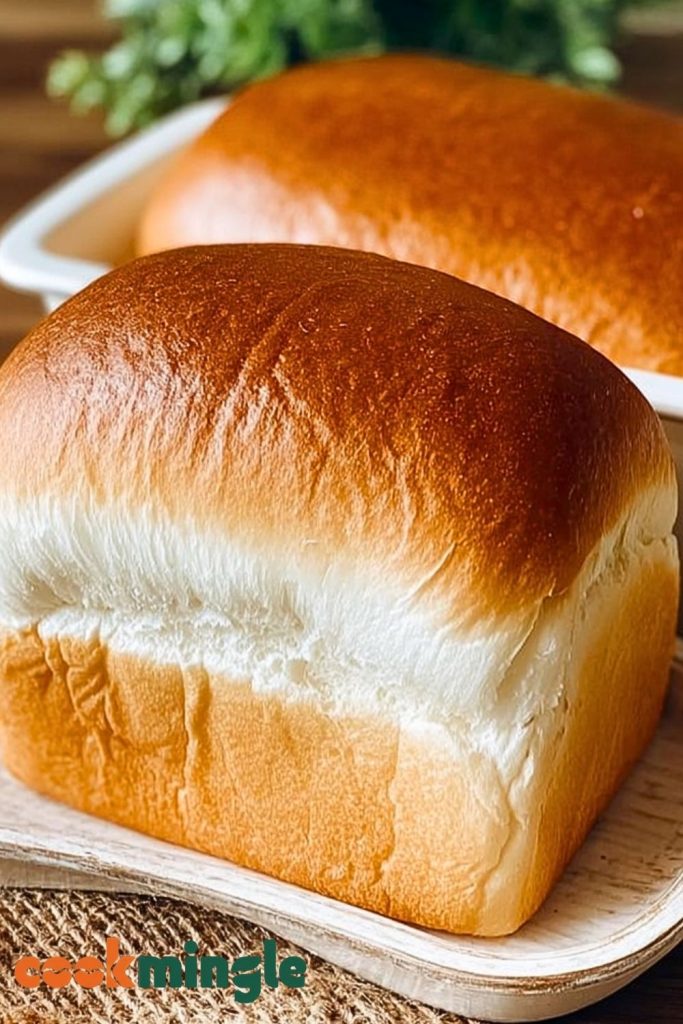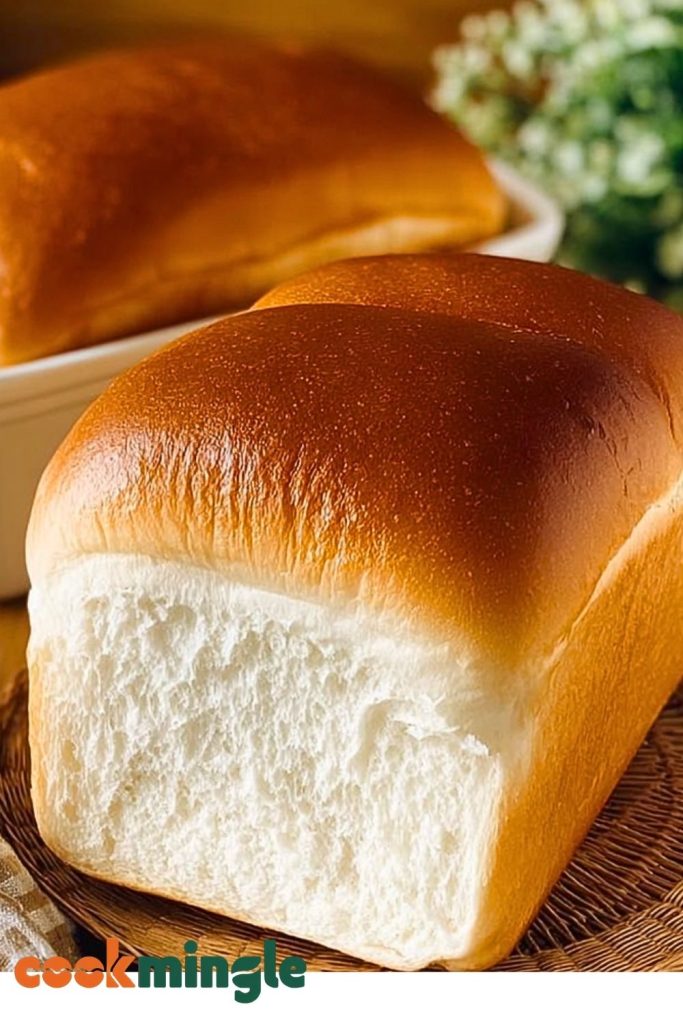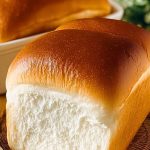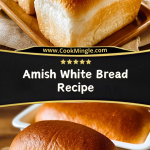Soft, fluffy, and slightly sweet—Amish White Bread is the kind of homemade loaf that never lasts long in my kitchen. I grew up with the smell of fresh bread wafting through the house, and this recipe brings back every bit of that cozy, nostalgic magic. It’s a classic, no-fuss bread that delivers a cloud-like interior and a golden-brown crust every single time.

What I love most about this bread is how approachable it is. Whether you’re a seasoned baker or a beginner trying your hand at yeast for the first time, Amish White Bread makes the process feel like second nature. I often double the batch and freeze one loaf, but if I’m honest, both are usually gone before the week is out.
Why You’ll Love This Amish White Bread
This isn’t just another white bread recipe—it’s comfort in every slice. You’ll love it because:
- It’s incredibly soft and pillowy.
- The touch of sweetness makes it perfect for sandwiches, toast, or snacking on its own.
- No stand mixer needed—just simple ingredients and a little patience.
- It freezes beautifully, making it a great make-ahead option.
- Your kitchen will smell like a dream while it bakes.
What Kind of Flour Should I Use for Amish White Bread?
For this recipe, I always reach for all-purpose flour. It creates that perfectly tender crumb that makes Amish White Bread so irresistible. If you’re after a slightly chewier texture or want a heartier bite, bread flour is a solid substitute—it has more protein, which helps with structure and chew.
That said, I wouldn’t recommend using whole wheat flour exclusively for this recipe. It changes the texture and density too much, though you could swap in up to one-third whole wheat flour if you’re after a bit more fiber without sacrificing too much softness.
Options for Substitutions
Need to adjust the recipe to fit your pantry or dietary needs? Here are a few flexible swaps:
- Milk Instead of Water: Swap part or all of the water for warm milk to make the bread even richer and softer.
- Honey Instead of Sugar: If you prefer a more natural sweetener, use honey in equal measure for a deeper, mellow sweetness.
- Butter in Place of Oil: Melted butter adds extra flavor and a slightly more tender texture compared to oil.
- Instant Yeast Instead of Active Dry: You can substitute instant yeast—just skip the proofing step and mix it right into the flour.
These tweaks won’t drastically change the outcome, so feel free to make it your own without stress.
Ingredients for This Amish White Bread
Each ingredient in this Amish White Bread recipe plays a key role in creating its soft texture and slightly sweet flavor. Here’s what you’ll need and why it matters:
- Warm Water – Activates the yeast and hydrates the dough, setting the stage for a fluffy rise.
- Granulated Sugar – Adds a hint of sweetness and helps feed the yeast for a better rise.
- Active Dry Yeast – The rising agent that gives the bread its beautiful height and airy crumb.
- Salt – Balances the sweetness and enhances the overall flavor of the bread.
- Vegetable Oil – Keeps the crumb moist and soft, and helps the dough remain easy to work with.
- All-Purpose Flour – The foundation of the dough; it gives structure while keeping the bread tender and light.
These are pantry staples, which makes this recipe even more appealing—nothing fancy, just good, honest ingredients working together.

Step 1: Proof the Yeast
In a large mixing bowl, combine warm water (about 110°F/43°C) with the sugar. Stir until dissolved, then sprinkle the active dry yeast over the top. Let it sit for 5–10 minutes until it becomes frothy. This means your yeast is alive and ready to go.
Step 2: Add Oil and Salt
Once the yeast is bubbly, add the vegetable oil and salt. Stir to combine, preparing the liquid base of your dough.
Step 3: Mix in the Flour
Gradually add the all-purpose flour, one cup at a time, mixing as you go. As the dough starts to come together, switch to kneading by hand or using a dough hook. You want a soft, slightly tacky dough that pulls away from the sides of the bowl.
Step 4: Knead the Dough
Knead the dough for about 8–10 minutes on a floured surface (or with a stand mixer), until it’s smooth and elastic. It should bounce back when lightly pressed.
Step 5: First Rise
Place the kneaded dough in a lightly oiled bowl, turning it to coat all sides. Cover with a damp towel or plastic wrap and let it rise in a warm spot for 1 to 1½ hours, or until doubled in size.
Step 6: Shape and Second Rise
Punch down the dough to release air bubbles, then divide it into two equal parts. Shape into loaves and place them in greased 9×5 inch loaf pans. Cover again and let them rise for another 30–45 minutes, until they’ve puffed up nicely.
Step 7: Bake
Preheat your oven to 350°F (175°C). Bake the loaves for 25–30 minutes, or until the tops are golden brown and the bread sounds hollow when tapped.
Step 8: Cool
Remove the loaves from the pans and let them cool on a wire rack. Try to resist cutting into them too early—cooling helps the structure set properly.
How Long to Cook the Amish White Bread
Once your loaves are fully proofed and ready to bake, they’ll need about 25 to 30 minutes in a 350°F (175°C) oven. You’re looking for a deep golden brown top and that classic hollow sound when you gently tap the crust. If you’re unsure, a thermometer inserted in the center should read around 190°F (88°C) for perfectly baked bread.
Tips for Perfect Amish White Bread
- Use the right water temperature. Too hot will kill the yeast, too cold and it won’t activate. Aim for about 110°F (43°C).
- Don’t over-flour. The dough should feel soft and slightly tacky—adding too much flour makes dense bread.
- Knead long enough. Proper kneading builds gluten, which gives the bread structure and that soft pull-apart interior.
- Let it rise properly. Be patient with both rises. Rushing this step leads to underdeveloped flavor and flat loaves.
- Brush with butter. Right after baking, a light butter brush over the tops gives a beautiful sheen and extra flavor.
- Cool before slicing. Slicing too soon lets steam escape and can make the bread gummy inside.
Watch Out for These Mistakes While Cooking
Even with a simple recipe like Amish White Bread, a few missteps can sneak in. Here’s what to avoid:
- Killing the yeast: Water that’s too hot can kill the yeast before it activates. Always check the temperature if you’re unsure.
- Adding too much flour: It’s tempting to keep adding flour when the dough is sticky, but too much leads to a dry, dense loaf.
- Under-kneading: If your dough doesn’t develop enough gluten, your bread won’t rise properly or have that soft structure.
- Over-proofing: Letting the dough rise too long can make it collapse during baking. It should double—not triple—in size.
- Cutting too soon: Slicing while hot may cause the bread to squish and become gummy inside. Let it cool completely on a wire rack.
What to Serve With Amish White Bread?
This bread is endlessly versatile. Here are some delicious pairings and ways to enjoy it:
Classic Sandwiches
Make a killer ham and cheese or a BLT with thick slices of this soft, sweet bread.
Morning Toast
Toast it and slather on butter, jam, or peanut butter for a simple and satisfying breakfast.
French Toast
Its soft texture and subtle sweetness make it ideal for a rich, custardy French toast.
Soup Companion
Serve it warm with a bowl of creamy tomato, chicken noodle, or vegetable soup—it’s perfect for dipping.
Bread Pudding
Cube up day-old slices and turn them into a decadent dessert or brunch dish.
Garlic Bread
Brush slices with garlic butter, toast until golden, and serve with pasta or salad.
Grilled Cheese
Melts beautifully with cheddar, mozzarella, or a mix—perfect for a golden, crispy grilled cheese.
Egg-in-a-Hole
Cut a circle in a slice, crack in an egg, and pan-fry for a quick and fun breakfast.
Storage Instructions
Amish White Bread stays fresh longer than many homemade loaves, thanks to its slightly enriched dough. Here’s how to keep it soft and delicious:
- At Room Temperature: Store in an airtight bag or container for up to 4 days. Keep it in a cool, dry spot—avoid the fridge, as it dries out the crumb faster.
- Freezing: Wrap the cooled loaf (or slices) tightly in plastic wrap and foil, then freeze for up to 3 months. Thaw at room temperature or pop slices in the toaster straight from frozen.
- Reheating: If your bread starts to feel a bit stale, a quick toast or a warm-up in the oven wrapped in foil will bring back its soft texture.
Estimated Nutrition (per slice, based on 16 slices per loaf)
- Calories: ~140
- Total Fat: 3g
- Saturated Fat: 0.5g
- Cholesterol: 0mg
- Sodium: 160mg
- Total Carbohydrates: 25g
- Dietary Fiber: 1g
- Sugars: 4g
- Protein: 3g
These values can vary slightly depending on your substitutions or loaf size, but this gives a solid estimate if you’re keeping track of nutrition.
Frequently Asked Questions
What makes Amish White Bread different from regular white bread?
Amish White Bread is slightly sweeter and softer than traditional white bread. It’s made with sugar and oil, which give it a tender, moist crumb and a lightly golden crust.
Can I use a bread machine for this recipe?
Yes, you can! Just add the ingredients in the order your bread machine recommends (usually liquids first), and use the basic white bread setting. You may want to reduce the flour slightly if your machine runs hot.
Why didn’t my dough rise?
Check your yeast—it may be expired or was killed by water that was too hot. Also, make sure you let it rise in a warm, draft-free area. Cold kitchens slow down the process significantly.
Can I make rolls instead of loaves?
Absolutely. Divide the dough into even portions and shape into rolls. Place them on a baking sheet and bake for 15–18 minutes, until golden brown.
How do I know if I’ve kneaded the dough enough?
The dough should be smooth, elastic, and bounce back when lightly pressed. You can also do the “windowpane test”: stretch a small piece—if it forms a thin sheet without tearing, it’s ready.
Can I reduce the sugar?
Yes, but keep at least a tablespoon to help activate the yeast. Reducing sugar will affect both flavor and browning, but it’ll still be a good loaf.
What kind of oil works best?
Neutral oils like vegetable, canola, or sunflower work best. You can also use melted butter or olive oil for added flavor.
How do I get a shinier crust?
Brush the top of the loaf with melted butter after baking for a soft, shiny finish. For a slightly crispier crust, brush with egg wash before baking.
Conclusion
Amish White Bread is one of those timeless recipes that feels like a warm hug from the oven. It’s simple, reliable, and tastes like something that came straight out of grandma’s kitchen. Whether you’re baking your first loaf or your hundredth, this bread will quickly become a favorite. Serve it with everything or eat it warm with a pat of butter—either way, you’ll never look at store-bought bread the same again.

Amish White Bread Recipe
- Total Time: 2 hours 30 minutes
- Yield: 2 loaves
- Diet: Vegetarian
Description
This soft, sweet, and pillowy Amish White Bread is a timeless classic that’s easy to make and impossible to resist. Whether you’re a baking beginner or a seasoned pro, this loaf comes together with just a few pantry staples and a little love. Perfect for quick breakfasts, easy dinners, or family-friendly snacks, this bread delivers a fluffy crumb, golden crust, and nostalgic flavor in every slice. If you’re looking for bread ideas, simple food recipes, or breakfast recipes from scratch, this one’s a keeper.
Ingredients
2 cups warm water
⅔ cup granulated sugar
1 ½ tablespoons active dry yeast
1 ½ teaspoons salt
¼ cup vegetable oil
6 cups all-purpose flour
Instructions
1. In a large bowl, stir warm water and sugar until dissolved, then sprinkle in the yeast. Let it sit for 5–10 minutes until foamy.
2. Add vegetable oil and salt to the yeast mixture. Stir to combine.
3. Gradually mix in the flour, one cup at a time, until a dough forms.
4. Knead the dough for 8–10 minutes, until smooth and elastic.
5. Place the dough in a greased bowl, turning to coat. Cover and let it rise for 1 to 1½ hours or until doubled in size.
6. Punch down the dough, divide into two portions, and shape into loaves.
7. Place in greased 9×5 inch loaf pans. Cover and let rise again for 30–45 minutes.
8. Preheat the oven to 350°F (175°C).
9. Bake the loaves for 25–30 minutes or until golden brown and they sound hollow when tapped.
10. Remove from pans and cool on wire racks before slicing.
Notes
Make sure your water is warm, not hot—about 110°F is ideal for activating yeast.
You can use bread flour for a slightly chewier texture, but all-purpose flour works perfectly.
Let the bread cool fully before slicing to keep the crumb soft and avoid gumminess.
- Prep Time: 15 minutes
- Cook Time: 30 minutes
- Category: Bread
- Method: Baking
- Cuisine: American
Nutrition
- Serving Size: 1 slice
- Calories: 140
- Sugar: 4g
- Sodium: 160mg
- Fat: 3g
- Saturated Fat: 0.5g
- Unsaturated Fat: 2.5g
- Trans Fat: 0g
- Carbohydrates: 25g
- Fiber: 1g
- Protein: 3g
- Cholesterol: 0mg

